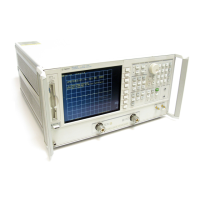4- 35
Printing, Plotting, and Saving Measurement Results
Saving and Recalling Instrument States
What You Can Save to a Floppy Disk
You can save an instrument state and measurement results to a disk. The default file names are FILEn,
where n gets incremented by one each time a file with a default name is added to the directory. The default
file names for data-only files are DATAyDz (DATAy.Dz for DOS), where y is incremented by one each time a
file with a default name is added to the directory. The z is the channel where the measurement was made.
When you save a file to disk, you can choose to save some or all of the following:
• all settings listed for internal memory
• active error-correction for the active channel only
• displayed measurement data trace
• displayed user graphics
• data only
•HPGL plots
What You Can Save to a Computer
Instrument states can be saved to and recalled from an external computer (system controller) using GPIB
mnemonics. For more information about the specific analyzer settings that can be saved, refer to the output
commands located in the "Command Reference" chapter of the programmer's guide. For an example
program, refer to the "Programming Examples" chapter of the programmer's guide.

